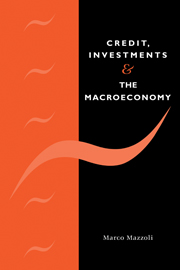Book contents
- Frontmatter
- Contents
- Preface and acknowledgements
- 1 Introduction
- Part I Banks, credit and the macroeconomy: a puzzle
- 2 Credit, financial markets and the macroeconomy: different approaches and a proposed perspective
- 3 Securitization and the empirics of bank credit
- Part II Interactions between credit and industry: firms' market power and banks' liquidity preference
- Part III ‘Inside-the-firm’ interactions between finance and investments
- Summing up …
- Bibliography
- Index
3 - Securitization and the empirics of bank credit
from Part I - Banks, credit and the macroeconomy: a puzzle
Published online by Cambridge University Press: 03 February 2010
- Frontmatter
- Contents
- Preface and acknowledgements
- 1 Introduction
- Part I Banks, credit and the macroeconomy: a puzzle
- 2 Credit, financial markets and the macroeconomy: different approaches and a proposed perspective
- 3 Securitization and the empirics of bank credit
- Part II Interactions between credit and industry: firms' market power and banks' liquidity preference
- Part III ‘Inside-the-firm’ interactions between finance and investments
- Summing up …
- Bibliography
- Index
Summary
Securitization and the macroeconomy
In chapter 2 it was suggested that Williamson's (1985) contractual framework is a valuable tool to interpret the phenomenon of securitization. One of the premises of the ‘credit view’ is the idea that bank credit and security markets are not perfect substitutes. Furthermore, for a large number of small and medium-sized industrial firms bank loans are almost the only external source of finance. However this idea has not only been expressed in the ‘creditist’ literature. If, as Fama (1985) suggests, bank credit is a nonsubstitutable source of finance for the firms penalized on bond and share markets by phenomena of asymmetric information and agency costs, then in a ‘securitized’ financial system banks would conceivably face two different kinds of customers: firms not penalized on capital markets, for which the different sources of funds are substitutable, and firms penalized on capital markets. Firms of the first type (usually big corporations with a ‘strong’ reputation), due to the high substitutability among the different sources of funds, would probably express a more unstable demand for bank credit than firms of the second. Therefore, since big and well reputed firms express a relevant share of the aggregate economic activity, in a ‘securitized’ financial system the demand for bank credit to the industries should be, ceterisparibus, more unstable than in ‘non-securitized’ systems. This means that a situation where the demand for bank credit to the industries is more unstable than the supply is more likely to be found in a securitized financial system than in a non-securitized one.
- Type
- Chapter
- Information
- Credit, Investments and the MacroeconomyA Few Open Issues, pp. 56 - 84Publisher: Cambridge University PressPrint publication year: 1998
- 1
- Cited by



